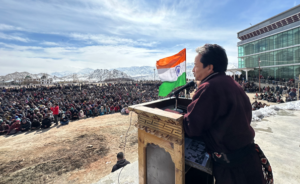The Himalayas lost an important battle December 14, 2021: The Supreme court ruled in favour of a massively wide, 10-meters tarred surface, double-lane paved shoulder (DL-PS), road width design for the Char Dham Pariyojna (CDP).
This route, which connects the four ancient Himalayan pilgrimages, runs through fragile valleys of the pristine Bhagirathi: The Ganga, Alaknanda, Mandakini and Yamuna.
The Rs 12,000 crore project envisages improvement as well as the development of 889-km-long national highways.
Petitioners and experts of the high-powered committee (HPC) tasked with reviewing this project had pleaded for a narrower intermediate width (IW), 5.5-metres tarred surface.
The Supreme Court had also validated this IW width in September 2020. The Union defence ministry (MoD) intervened in November 2020, asking for a double lane (DL) configuration (7m tarred surface), instead of DL-PS, for three strategic stretches of National Highway (NH)-94, NH-125, NH-58.
These national highways comprise 700 km of the total project.
The 83-page-long judgment dwells at length on the concept of ‘sustainable development. Quoting laudably from several previous judgments, it stresses the need to balance social and economic needs with environmental considerations; that development cannot be separated from human rights, where development means the right to the realisation of one’s full potential.
It quotes sustainability as implying preservation for the present and future generations. It emphasises that sustainable development is not merely for redressal, but also to prevent failures in protecting the environment. There is nothing to disagree with here.
Then it arrives at the heart of its argument. It states: This court in its exercise of judicial review cannot second guess the infrastructural needs of the Armed forces… This is impermissible.
Nothing to disagree with here either. In the same vein, it specifies: Balancing the interests of defence as against environmental considerations was outside the ambit of the HPC.
But a director-level officer of the Union defence ministry was always part of the HPC. And such a ‘balancing’ was never quite the intention.
The chairman-led minority experts and petitioners have repeatedly pointed out that the requirement of the Army was not the issue of contention. The Army may require DL-PS or a six-lane highway, but on the ground, the Himalayas cannot support such a width without collapse and slope failures, of which the HPC report has detailed observations.
Surely, it is field experts who can evaluate the same. That such a collapse has led to serious impediment of all mobility has been seen in the last two years: Landslides, roadblocks and numerous tragic deaths have been reported.
The Union Ministry of Road Transport and Highways (MoRTH) reported over 200 landslides in 2021. NH-58 and NH-94 of the CDP, both of strategic importance for the MoD, were closed indefinitely by the district magistrate, “as it was unsafe for commuters due to falling debris, boulders and collapsing ‘protection’ walls.”
On NH-58, 18 slope failures / debris fall were reported in a single day. A landslide occurred at Totaghati, a site that was completely stable before CDP hill-cutting began.
But it has become a recurring landslide zone for the last one-and-a-half years. The slope failures were continuous and uncontainable this monsoon.
On NH-94, a 25-30-metre section of the tarred road collapsed and sank due to heavy rains. Both stretches were completed to DL-PS width, with tarring and protection walls.
MoRTH reported October 2020 that 72 landslides were triggered on NH-125. Thus, despite paper assurances, not only were all our agencies unable to cope with the extent of slope failures, clear them, or prevent them, our defence mobility was also seriously compromised. This fundamental concern, however, remains unanswered in the judgment.
The judgment also delves into government circulars, all hasty, arbitrarily amended documents, to justify the DL-PS standard. The MoRTH 2020 circular that amended the MoRTH 2018 circular, which specifically recommended IW for hilly terrain, was done on December 15, 2020, the day HPC met to consider the affidavit of the MoD.
It recommended DL-PS, and was presented to the HPC right in the middle of deliberations, where the government-constituted majority immediately opinionated accordingly.
Next quoted are the error-ridden IRC 2019 guidelines, hurriedly revised in August 2019: They actually stipulate DL-PS for all roads from highways to small district and village roads, without bothering to alter the legal ‘right of way’.
The judgment, which also sanctions DL-PS within the fragile Bhagirathi eco-sensitive zone (BESZ), made its most glaring mistake when it relied on the Attorney General’s statement regarding amendment of the BESZ notification, which he misquoted as “permitting work for national security infrastructure without the due study of environmental impacts”.
In fact, the amendment read the opposite: Works related to re-construction, disaster mitigation, lift irrigation, hospitals, schools, food godowns and other social and national security infrastructures shall be carried out with due study of environmental impacts and complying with their mitigation options.
Moreover, the integrity of this amendment can be assessed from the fact that this clause was placed in the category of ‘promoted activities’ alongside organic farming, rainwater harvesting and solar energy.
The defence infrastructure was already included in the ‘regulated section’ of the notification. The misplaced enthusiasm to sanction DL-PS was further undermined by MoRTH and BRO (MoD), who decided upon IW for certain stretches in this zone.
Ten years ago, our country united to preserve the last stretch of the pristine Ganga in the valley of her origin (Uttarkashi-Gangotri). At least three hydroelectric projects were cancelled. The valley was declared an eco-sensitive zone to ensure permanent protection of the catchment area of the Ganga.
All it takes is one massive blunder to undo years of protection.
The judgment states that the MoD has had a “consistent stand” in this matter. This is incorrect: In November 2020, the MoD filed its first application and pleaded for double lane configuration (7m tarred surface) for defence mobility.
In fact, the judgment has now sanctioned DL-PS, but the MoD had only asked for DL until all government circulars were amended to DL-PS. At the point in January 2021, however, the MoD also changed its stand in court accordingly.
The judgment accepts on face value the breaking up of this single project into 53 ‘packages’ on grounds of its several stand-alone tunnels and bypasses, though the partition was done to evade the environmental impact assessment.
In fact, an aerial view showed the entire project wound up within a limited radius of 50km. The intermediate width was rejected, when it would have allowed for smooth flow of bilateral traffic with minimum slope failures and ecological devastation.
There are other incongruencies, such as building a walking path for pilgrims according to HPC unanimous recommendations. Experts have pointed out that the DL-PS width leaves no room for walking.
The judgment states that since more than half of cutting for DL-PS had already happened on some stretches, IW will not be suitable for the rest without acknowledging that these works were done in violation of 2018 circular valid at the time, the Supreme court formulated HPC as well as the Supreme court order of September 8, 2020.
Thus, the judgment rewards violations instead of establishing accountability. The monumental crisis of climate change has not been factored in.
Unfortunately, the old reductionist approach of pitting white against black prevailed, with a fundamental incomprehension of the very rules of the game.
When mountains are turned to muck, and the Himalayas are made further vulnerable to extreme weather disasters, what ‘full potential’ are we realising?
And so pivotal are these blessed peaks to our nation’s security, its climate, its water, its beauty, its wealth, its food, its air. It is no exaggeration to say that when the Himalayas lose, India loses it all.
(Priyadarshini Patel is a head member of Ganga Ahvaan, a citizen forum working towards the conservation of the Ganga and the Himalayas. She initiated the movement of conserving the last pristine stretch of the Ganga, from Gangotri to Uttarkashi, which is now the Bhagirathi eco-sensitive zone. Courtesy: Down to Earth.)




